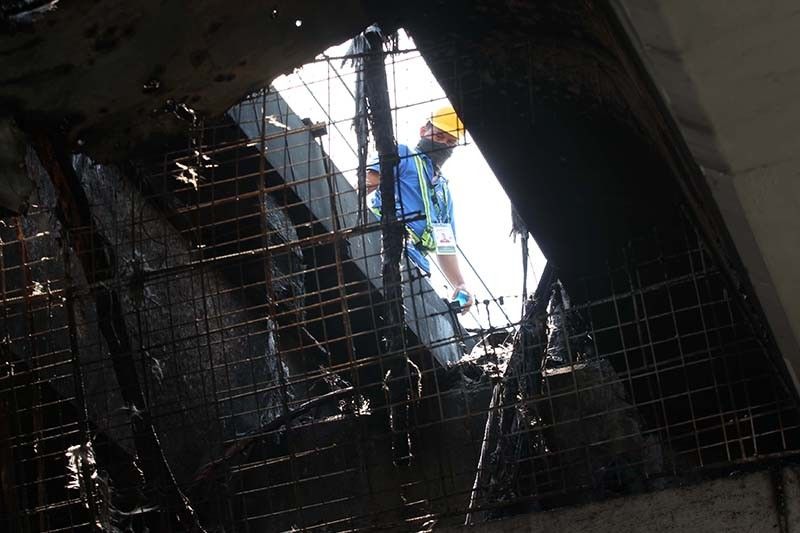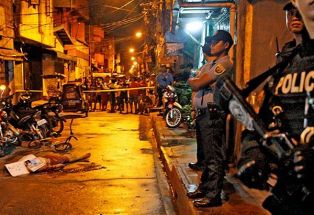Temporary LRT-2 shutdown after fire highlights need for structural change, better inspections

MANILA, Philippines — The total shutdown of the Light Rail Transit Line 2—the only train system in Metro Manila running from east to west— on Thursday after its transformer burst into flames shows the need for a structural revamp as well as further inspections of other railway lines.
An urban planner stressed this Friday as the incident forced LRT-2 management to temporarily stop operations, affecting an estimated 200,000 passengers who use the line daily.
Shortly before noon on Thursday, the rectifier-transformer located between LRT-2's Katipunan and Anonas stations tripped and caught fire. The fire was contained at around 12:30 p.m. but repairs will mean partial operations on the train line for nine months.
RELATED: Power glitches disrupt LRT-2, MRT-3 operations
Julius Dalay, chair of the advocacy group Commuters of the Philippines, said the incident is a call for a better management structure.
He cited a Japan International Cooperation Agency study on the Mega Manila subway that proposed a “Mega Manila Transit Authority”—a single authority for metro-wide public transportation.
“It creates a continuous authority similar to how London, Seoul and Tokyo do where there is a central localized authority that is detached from the Department of Transportation or their transportation departments abroad that are more adept in managing the situation in the metropolitan area,” Dalay told Philstar.com in a phone interview.
LRT-2 is operated by the Light Rail Transit Authority, a government-owned and -controlled corporation attached to the DOTr.
READ: 3 LRT-2 stations offline for 9 months after fire
National Transportation Safety Board needed
Dalay added a National Transportation Safety Board should also be in place to independently investigate transportation-related incidents
“NTSB is also needed because how do we know that this is not a sabotage or something?" he said.
"Of course, they would investigate the cause of the incident but they would investigate their own misdoings so they could skew their findings toward their favor as opposed to what’s done abroad where a third party would determine if it was caused by human error, mismanagement, poor maintenance or defect in design."
The US NTSB is a federal agency that investigates "every civil aviation accident in the United States and significant accidents in other modes of transportation – railroad, highway, marine and pipeline," the agency says on its website. Aside from investigation, the agency comes out with safety recommendations to prevent similar accidents in the future.
Last month, three Senate committees recommended the creation of a Philippine NTSB, which will conduct independent investigations on transportation incidents, support safety programs and assess operating practices of government agencies involved in the transportation sector.
LRTA on Friday said it would be able to resume partial operations—only from Cubao to Recto stations—by next week. But there will be no train operations in Santolan, Katipunan and Anonas stations for the next nine months.
Focus is on MRT-3
The incident should also prod authorities to further inspect train systems in the country, Dalay stressed.
“Right now, the focus is always on Metro Rail Transit Line-3 that we tend to forget we still have other lines in the system. Now that the incident happened, it is only when LRT-2 is given attention,” he said.
“And would we still wait for lives to be lost for us to really call a hearing, do something about it?” the urban planner also said, adding it creates fear among the riding public.
No one was reported hurt in the incident but it left thousands of LRT-2 commuters stranded.
Maintenance issue
Thursday’s fire that subsequently led to the shutdown of operations can be attributed to poor maintenance of the train line.
“Basically, what happened in Katipunan is roughly corruption and poor maintenance. Systems like these are supposed to be running like clockwork, in which a fire should not happen because it should have proper maintenance,” Dalay said.
TSPA Joint Venture is the maintenance contractor for LRT-2 system.
Last May, a malfunctioning train crashed into a passenger train on the eastbound tracks between Cubao and Anonas stations, leaving at least 34 people injured. The defective train had been parked along the emergency lane and was supposed to be towed toward the depot after operational hours.
“Trains are supposed to last for 30 to 40 years, even extending to 50 years but line 2 is just 15, 16 years. Trains undergo major rehabilitation and upgrade after 10 to 15 years during service to increase reliability and to make it better to meet the lack of spare parts,” Dalay said.
When LRT-2 began its operations in 2003, there were 18 train sets. The number of trains running is now down to seven, lesser than the ideal number of 12 trains.
The LRT-2 management is reportedly planning to procure 14 more trains. But Dalay said that instead of procuring additional trains, LRTA should rehabilitate its trains because it is “cheaper.”
Eighteen trains are also enough given the ridership of the system, he added.
The line’s east extension is currently under construction. The extension calls for two additional stations: one near Sta. Lucia East Grandmall in Cainta and another near SM City Masinag in Antipolo.
LRT-2 or MRT-2?
LRT-2 is not actually a light rail system, Dalay said.
“Line 2 is not actually an LRT; it’s actually what we experts calls as MRT—the true MRT. It’s not light rail system, it’s a heavy rail metro system,” he said.
According to the Transit Cooperative Research Program, a heavy rail transit system is “a transit system using trains of high-performance, electrically powered rail cars operating in exclusive rights-of-way, usually without grade crossings, with high platform stations.”
Meanwhile, a light rail transit is a “metropolitan electric railway system characterized by its ability to operate single cars or short trains along exclusive rights-of-way at ground level, aerial structures, in subways or occasionally in streets, and to board and discharge passengers at track or car floor level.”
Calling the train line "LRT-2" may be one of the reasons why LRTA has difficulty procuring parts not only for its trains but also for subsystems.
“If you’re gonna look back further at LRT mandate, nakasulat kasi dun na may provision dun on tax exemption on LRT parts and service. Going back to the point, possible na di maipasok ng LRTA ‘yung clause na ‘yun sa prinoprocure na parts sa Line 2 simply because naka-light rail system,” Dalay said.
Advocacy group MRT-2, a sister group of Commuters of the Philippines, said that Line 2 is actually Metro Manila’s first subway.
RELATED: Ground broken for first Metro Manila subway
“This might come as a surprise to most but ever wonder why balikbayans from places such as Singapore, Hong Kong, Tokyo and Seoul only compare this line to the MRTs, [Mass Transit Railway]s, metros or subways of these countries? Do you even notice how the trains are way bigger than those in LRT-1 and MRT-3?” MRT-2 wrote on Facebook.
Burden to commuters
The nine-month suspension of LRT-2 operations in Santolan, Katipunan, Anonas stations will definitely burden commuters who use the system—the only train network in Metro Manila that runs in an east-west direction.
The 16.75-kilometer line serves 11 stations. LRT-2’s western terminus is Recto station in Manila, while its eastern terminus is Santolan station in Pasig.
“It will have a huge impact to the point that if you’re gonna look at the road-based systems plying the same route, there are only jeepneys,” Dalay said, adding the temporary shutdown will create a “big shift” in the routine of LRT-2 passengers.
The Metropolitan Manila Development Authority is offering free bus rides to commuters affected by the temporary shutdown of LRT-2. The buses will shuttle passengers from the Santolan footbridge to the Cubao area.
Dalay said the government should take this as an opportunity to test run the modernization of public utility vehicles “hand in hand with current jeepneys.”
“Now is the time to deploy modern jeeps to augment while they are yet to restore the system to ferry commuters,” the urban planner said.
- Latest
- Trending


























